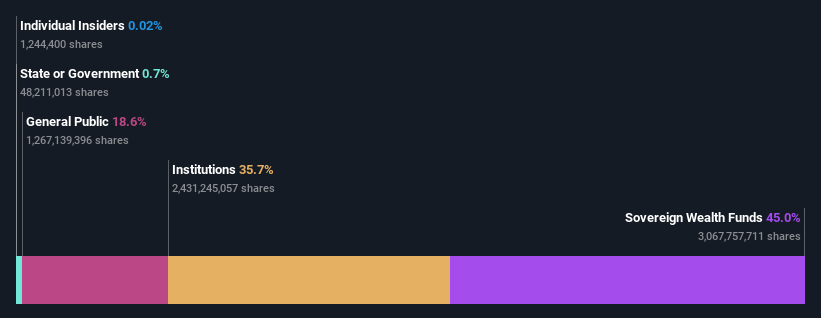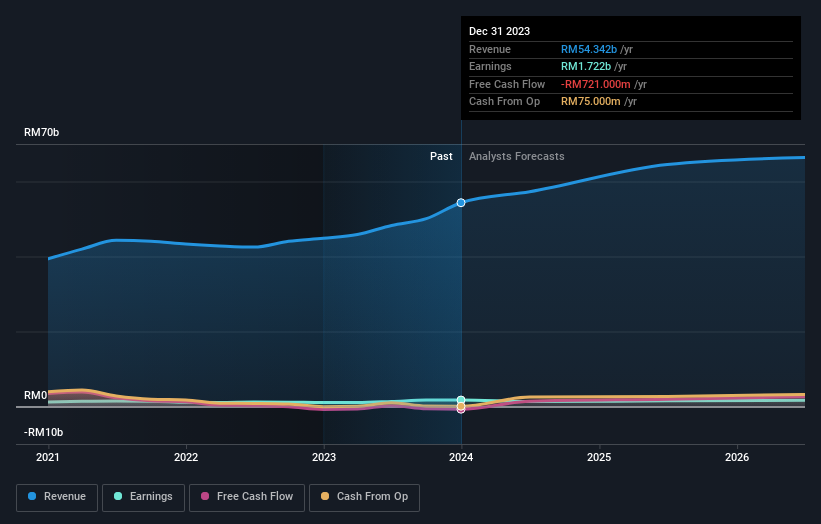Sovereign wealth funds who hold 45% of Sime Darby Berhad (KLSE:SIME) gained 3.8%, institutions profited as well
Key Insights
The considerable ownership by sovereign wealth funds in Sime Darby Berhad indicates that they collectively have a greater say in management and business strategy
59% of the business is held by the top 2 shareholders
A look at the shareholders of Sime Darby Berhad (KLSE:SIME) can tell us which group is most powerful. With 45% stake, sovereign wealth funds possess the maximum shares in the company. Put another way, the group faces the maximum upside potential (or downside risk).
While sovereign wealth funds were the group that benefitted the most from last week’s RM682m market cap gain, institutions too had a 36% share in those profits.
In the chart below, we zoom in on the different ownership groups of Sime Darby Berhad.
Check out our latest analysis for Sime Darby Berhad
What Does The Institutional Ownership Tell Us About Sime Darby Berhad?
Institutions typically measure themselves against a benchmark when reporting to their own investors, so they often become more enthusiastic about a stock once it's included in a major index. We would expect most companies to have some institutions on the register, especially if they are growing.
Sime Darby Berhad already has institutions on the share registry. Indeed, they own a respectable stake in the company. This can indicate that the company has a certain degree of credibility in the investment community. However, it is best to be wary of relying on the supposed validation that comes with institutional investors. They too, get it wrong sometimes. It is not uncommon to see a big share price drop if two large institutional investors try to sell out of a stock at the same time. So it is worth checking the past earnings trajectory of Sime Darby Berhad, (below). Of course, keep in mind that there are other factors to consider, too.
Hedge funds don't have many shares in Sime Darby Berhad. The company's largest shareholder is Permodalan Nasional Berhad, with ownership of 45%. Employees Provident Fund of Malaysia is the second largest shareholder owning 14% of common stock, and Kumpulan Wang Persaraan holds about 7.7% of the company stock.
A more detailed study of the shareholder registry showed us that 2 of the top shareholders have a considerable amount of ownership in the company, via their 59% stake.
While studying institutional ownership for a company can add value to your research, it is also a good practice to research analyst recommendations to get a deeper understand of a stock's expected performance. There are plenty of analysts covering the stock, so it might be worth seeing what they are forecasting, too.
Insider Ownership Of Sime Darby Berhad
The definition of an insider can differ slightly between different countries, but members of the board of directors always count. Management ultimately answers to the board. However, it is not uncommon for managers to be executive board members, especially if they are a founder or the CEO.
Insider ownership is positive when it signals leadership are thinking like the true owners of the company. However, high insider ownership can also give immense power to a small group within the company. This can be negative in some circumstances.
Our information suggests that Sime Darby Berhad insiders own under 1% of the company. Keep in mind that it's a big company, and the insiders own RM3.4m worth of shares. The absolute value might be more important than the proportional share. Arguably, recent buying and selling is just as important to consider. You can click here to see if insiders have been buying or selling.
General Public Ownership
With a 19% ownership, the general public, mostly comprising of individual investors, have some degree of sway over Sime Darby Berhad. This size of ownership, while considerable, may not be enough to change company policy if the decision is not in sync with other large shareholders.
Next Steps:
It's always worth thinking about the different groups who own shares in a company. But to understand Sime Darby Berhad better, we need to consider many other factors. Be aware that Sime Darby Berhad is showing 1 warning sign in our investment analysis , you should know about...
If you are like me, you may want to think about whether this company will grow or shrink. Luckily, you can check this free report showing analyst forecasts for its future.
NB: Figures in this article are calculated using data from the last twelve months, which refer to the 12-month period ending on the last date of the month the financial statement is dated. This may not be consistent with full year annual report figures.
Have feedback on this article? Concerned about the content? Get in touch with us directly. Alternatively, email editorial-team (at) simplywallst.com.
This article by Simply Wall St is general in nature. We provide commentary based on historical data and analyst forecasts only using an unbiased methodology and our articles are not intended to be financial advice. It does not constitute a recommendation to buy or sell any stock, and does not take account of your objectives, or your financial situation. We aim to bring you long-term focused analysis driven by fundamental data. Note that our analysis may not factor in the latest price-sensitive company announcements or qualitative material. Simply Wall St has no position in any stocks mentioned.

 Yahoo Finance
Yahoo Finance 

